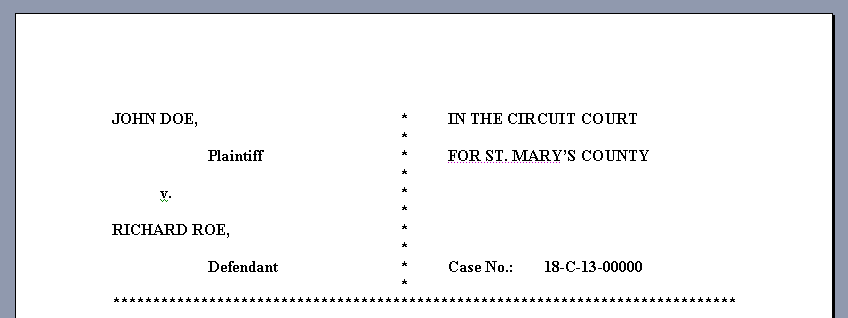Topics on this page:
- What is a motion?
- What do I do with the motion?
- How can I respond to a motion by the other party?
- Is it possible to change the deadline for a response?
- What should I include in a motion or response?
- How will the court handle the motion?
- Additional Resources
What is a motion?
A motion is a formal request asking the court to issue an order that a specific action be taken, either by the court or another party. For example, you can file a motion asking the court to dismiss some or all of the claims in a case (Motion to Dismiss), to exclude certain evidence the other party wants to admit (Motion to Suppress Evidence) or to reschedule a hearing, trial, or other proceeding (Motion for Continuance). You can also file motions asking the court to order the other party to disclose information or evidence relevant to the case (Motion for Discovery), to compel the other party to comply with discovery or already issued orders (Motion to Compel), or to order the other party to refrain from certain actions while the case is pending (Motion for Preliminary Injunction).
During a hearing or trial, you can make a motion verbally. At any other time, you must submit your motion in writing. Your motion must clearly state what you are asking the court to do.
What do I do with the motion?
You must file your written motion with the court. You must also serve a copy to the other parties in the case by You must file your written motion with the court and serve a copy to the other parties in the case. You can do this by delivering or mailing a copy of your motion to them. If a lawyer represents another party, you must deliver or mail that party’s copy to their lawyer.
After being served with a motion, the party served can file a written response to the motion with the court. A response must be filed within a set amount of time, usually 15 days. Generally, the court will not decide your motion until the other party has had this chance to respond.
If you are representing yourself, you can file your motion in paper or electronically. If you decide to file a motion electronically, you must e-file all future pleadings and papers with the court.
Read the Rules: Maryland Rules 1-321, ("Service of pleadings and papers other than original pleadings"), 1-322, ("Filing of pleadings, papers, and other items"), and 2-311 ("Motions")
How can I respond to a motion by the other party?
Generally, other parties must send you a copy of any motion they file against you in your case. Read the motion, and if you wish to, write a response to the motion. You must file your response with the court and send the other parties a copy. After being served with a motion, you must file your response with the court within the set time limit, usually 15 days.
NOTE: If the other party served you with a motion by mail, the court will allow you 3 extra days to file your response. In other words, you must usually file your response within 18 days of the date on which the other party mailed you the motion.
Read the Rule: Maryland Rule 1-203 ("Time")
Is it possible to change the deadline for a response?
In some circumstances, the court may be willing to issue an order shortening or extending the time allowed for filing a response to a motion. To ask the court to shorten or extend the time, you must file an additional motion with the court. Your motion must include a specific reason why the court should grant your request.
This additional motion might be called a “Motion to Extend [or Shorten] Time Requirements to Respond to [Title of Motion].” You must go through all the necessary steps to file and serve this additional motion with the court and serve it on the other parties.
As with any motion, the court may grant your motion to change the deadline, or the court may deny it. If the court issues an order granting your motion, the court may:
- shorten the time allowed,
- extend the time allowed (if the motion is filed before the expiration of the original period or the period extended by a previous order), or
- on motion filed after the expiration of the specified period, permit the act to be done if the failure to act was the result of excusable neglect.
RECOMMENDATION: If you are asking for more time to respond to another party’s motion, be sure to file your motion to extend time before the original deadline passes.
Read the Rules: Maryland Rule 1-204 ("Motion to shorten or extend time requirements")
What should I include in a motion or response?
- Case caption. Every paper you file must have a caption with the names of the parties (or, in some cases, the name of the case), the case number, and the name of the court hearing the case. This should appear at the top of the first page of your motion or response. See sample caption below:

Read the Rules: Maryland Rule 1-301 ("Form of court papers") - Title. Give your motion a short title describing the nature of the request. If you have no idea what to call your motion, you can call it “Motion for Appropriate Relief.” If you are responding to a motion, use a title like “Response to [Title of Motion] filed by [the party who filed the motion].” If you are requesting a hearing on the motion, you must state that in the title. The responding party can also request a hearing.
- Facts. State the facts that show why the court should grant the order you are seeking (or should not grant the order requested by the other party). Writing down your allegations and conclusions is not enough – you must include particular facts.
- Law. State the legal authority that supports your motion or response. This authority can consist of any kind of law, including a statute, a court rule, case law, or a previous court order in this case.
- Optional request for hearing. If you want a hearing on your motion or response, you must request a hearing under the heading “Request for Hearing.”
- Signature. If a lawyer does not represent you, you must sign any paper you file with the court. You must also include your address, telephone number, fax number (if any), and email address (if any).
Read the Rules: Maryland Rule 1-311 ("Signing of pleadings and other papers")
- Certificate of service. In order to file your motion or response with the court, you must include a signed certification stating that you gave or sent a copy to the other parties to the case, and stating the manner in which you did so (for example, by hand; by first-class mail, postage prepaid; by certified mail; or by another specified method). Include the name and address of any parties you mailed a copy to. Blank certificate of service.
Read the Rules: Maryland Rule 1-323 ("Proof of service")
- Affidavit. If your motion or response is based on facts that are not contained in the record, you must also file an affidavit to support those new facts.
Read the Rules: Maryland Rules 2-311 ("Motions") and 1-304 ("Form of Affidavit")
- Exhibits. If your motion or response is based on other papers or documents, or if you believe the court needs to consider another document in deciding the motion, attach that document as an exhibit.
How will the court handle the motion?
In most cases, after leaving time for the other parties to respond, the court will simply read the motion and response(s) and issue an order. In some cases, the court will schedule a hearing, to give you and the other party a chance to explain your arguments further. In most cases, the court does not have to grant a hearing.
Remember, if you want the court to hold a hearing before deciding your motion or response, you must ask for that. First, the title of your motion or response must state that you are requesting a hearing. Second, in the body of your motion or response, you must request a hearing under the heading “Request for Hearing.”
Read the Rules: Maryland Rule 2-311 ("Motions") and 1-301 ("Form of court papers")
Additional Resources
The Maryland State Law Library and many local or Circuit Court law libraries have form books with examples of motions that you can edit to meet your needs. Here are some frequently used Maryland form books:
- Maryland Civil Procedure Forms: with Practice Commentary, Robert Dale Klein (LEXIS Publishing).
- Maryland Practice: Civil Procedure Forms, George W. Liebmann (West Publishing Co.)
- Practice Manual for the Maryland Lawyer, Maryland State Bar Association, Young Lawyer' Section.
- Maryland litigation forms and analysis, Gary I. Strausberg ( Lawyers Cooperative Publishing )
In addition to these titles, there are also form books with motions that are focused on specific areas of law (family law, landlord-tenant, employment law, etc.). Your local law library will also be able to help you identify these sources.
Restricted Information Form from the Maryland Courts
{"preview_thumbnail":"/sites/default/files/styles/video_embed_wysiwyg_preview/public/video_thumbnails/stHo6WaSh28.jpg?itok=5h8pcpuN","video_url":"https://www.youtube.com/watch?v=stHo6WaSh28","settings":{"responsive":0,"width":"357","height":"223","autoplay":0},"settings_summary":["Embedded Video (357x223)."]}





